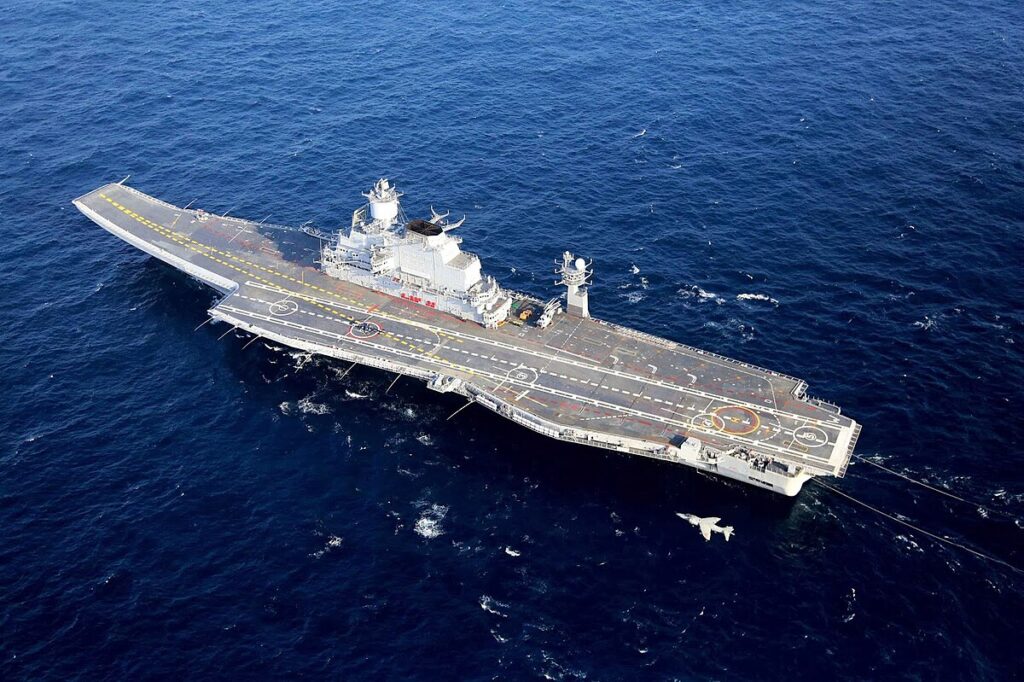A Soviet hull. An Indian heart. INS Vikramaditya is the carrier that turned a page for the Indian Navy. Its journey is bold. Its mission is clear.
From Admiral Gorshkov to Vikramaditya
The ship began as Admiral Gorshkov, a Kiev-class carrier. India signed the refit and acquisition deal in 2004. A complex rebuild followed at Sevmash in Russia. Finally, on 16 November 2013, the carrier was commissioned as INS Vikramaditya. Soon after, it sailed home to anchor India’s blue-water ambitions.
Why This Carrier Matters
- Reach: Extends air power far from shore.
- Readiness: Builds crew skills for larger carriers.
- Deterrence: Signals resolve in the Indian Ocean.
The Air Wing: Teeth of the Ship
Vikramaditya operates MiG-29K fighters. They deliver air superiority, precision strike, and maritime attack. The deck also hosts Kamov Ka-31 for AEW, Sea King for ASW/SAR, and ALH Dhruv for utility roles. A ski-jump launches jets fast. Arrestor gear recovers them safe.
At Sea: Drills, Patrols, Presence
The carrier spearheads major exercises. Think Malabar in the Indo-Pacific. Think bilateral drills with Russia and friendly navies. Regular patrols add vigilance. Port calls add diplomacy. Visibility builds trust and deterrence together.
Quick Specs
| Parameter | Figure (approx.) |
|---|---|
| Displacement | ~45,000 tonnes |
| Air Wing | ~30+ aircraft (fighters + helos) |
| Flight Deck | Ski-jump (STOBAR) |
| Primary Fighter | MiG-29K |
| Role | Sea control, strike, air defence, AEW |
Upgrades and Sustainment
Big ships need care. Boilers, sensors, and comms see periodic upgrades. Air ops systems evolve. So do safety, EW, and datalinks. The goal stays constant: higher availability and sharper punch.
Vikramaditya vs Vikrant: A Snapshot
| Aspect | INS Vikramaditya | INS Vikrant (IAC-1) |
|---|---|---|
| Origin | Rebuilt Soviet design | Indigenous (Cochin Shipyard) |
| Deck Type | STOBAR (ski-jump) | STOBAR (ski-jump) |
| Role Today | Operational flagship on West | New indigenous flagship |
| Significance | Bridge to modern carrier ops | Proof of Indian carrier design-build |
The Bigger Story: India’s Carrier Era
Vikramaditya bridged eras. It took India from legacy decks to modern ops. Then came the indigenous leap with INS Vikrant. Up next stands the proposed INS Vishal. One fleet. Many lessons. A clear trajectory.
Continue the Indian Navy Power Series
- Previously: INS Viraat – The “Grand Old Lady”
- Also read: INS Vikrant – India’s Indigenous Carrier
- Future: INS Vishal – The Next Leap
- Careers: How to Join the Indian Navy
For official recruitment notifications and entries, visit the Indian Navy portal: joinindiannavy.gov.in.
FAQs
What jets fly from INS Vikramaditya?
MiG-29K form the carrier’s main fighter arm. They handle air defence, strike, and maritime attack roles.
Why is Vikramaditya important if Vikrant is indigenous?
It ensures continuous carrier aviation while Vikrant ramps up. It also trained crews and systems for modern deck operations.
From Soviet steel to Indian strength—this ship proves adaptation wins at sea. Next, explore how indigenous design raises the bar with INS Vikrant.


